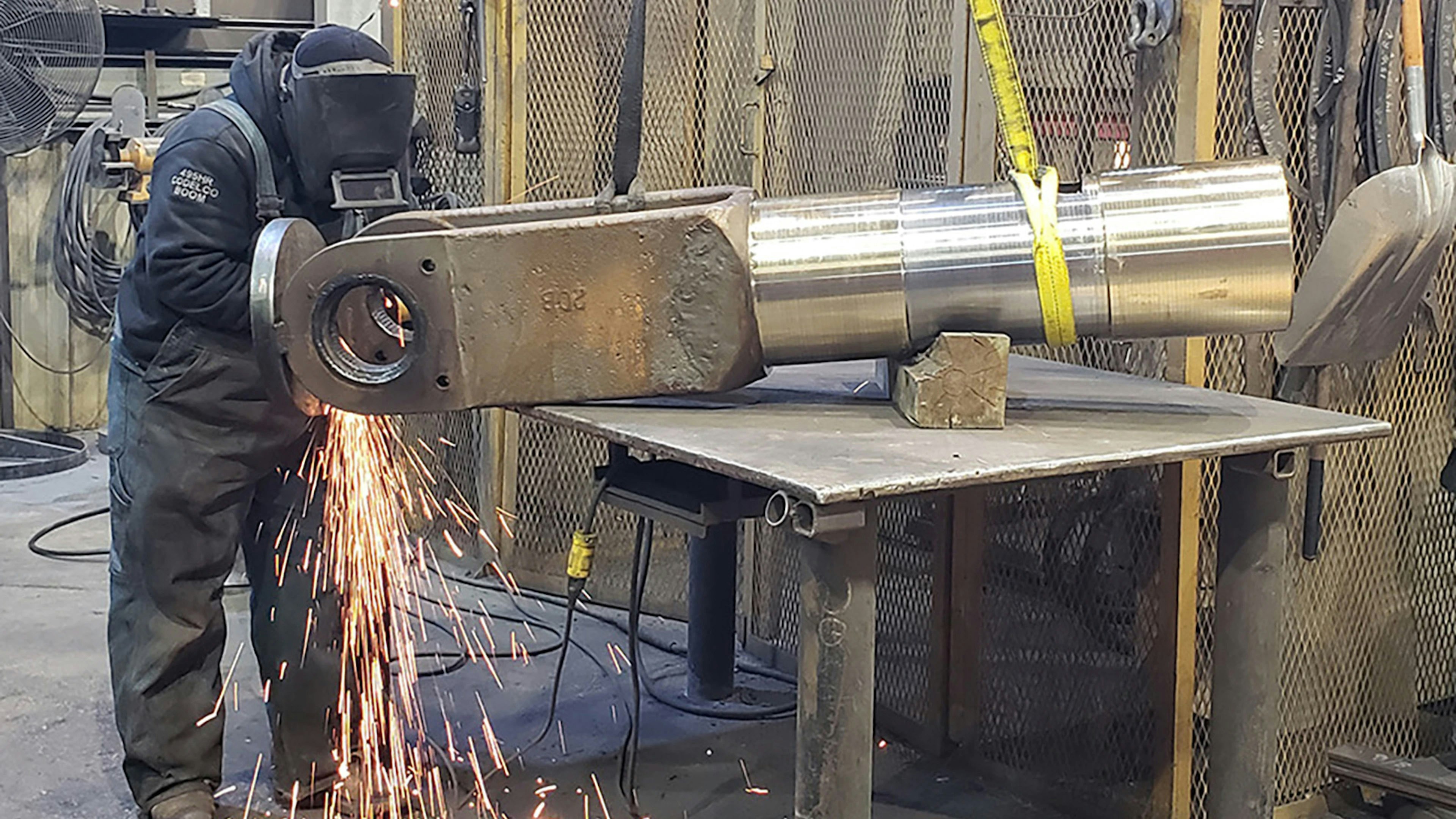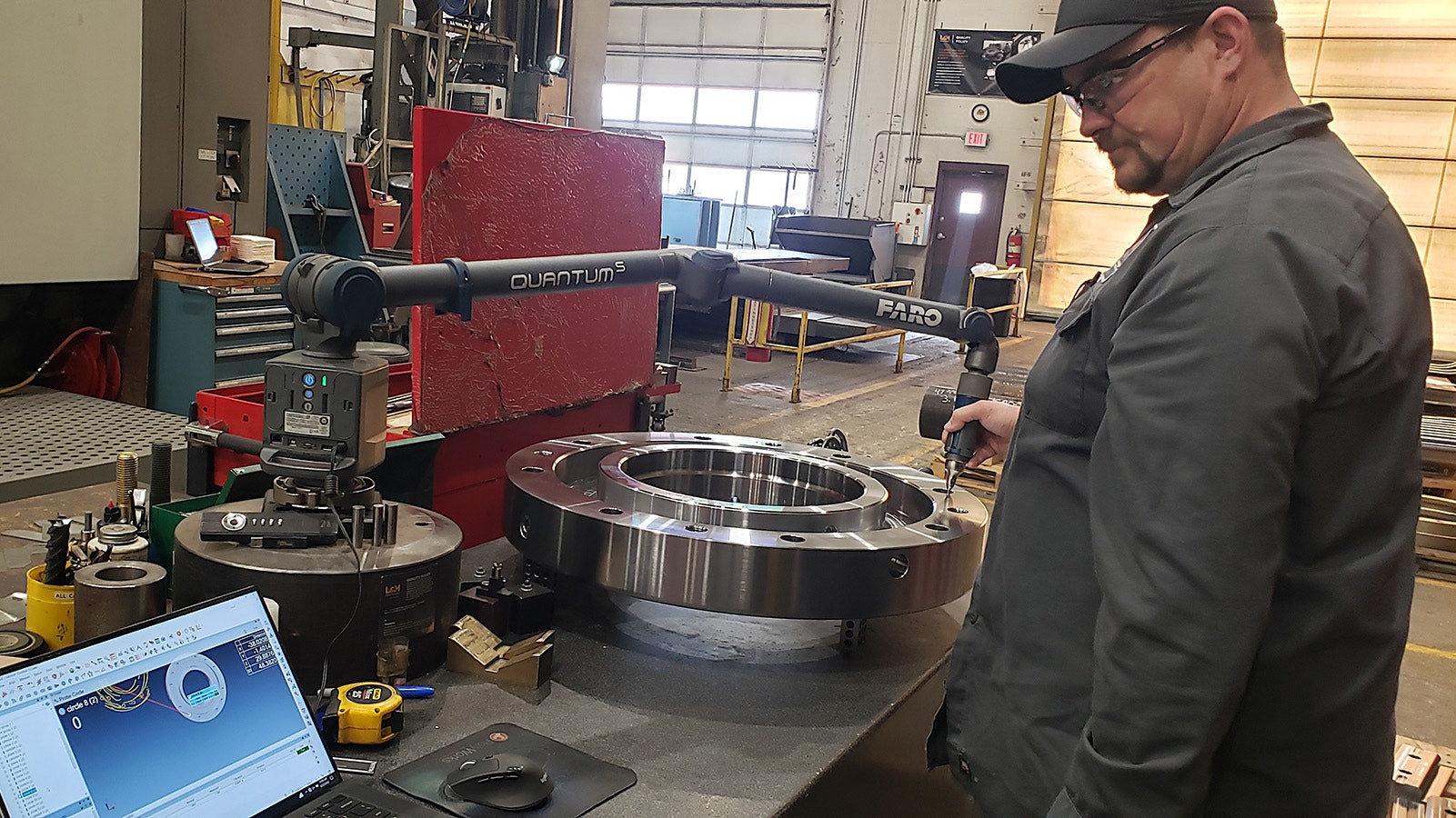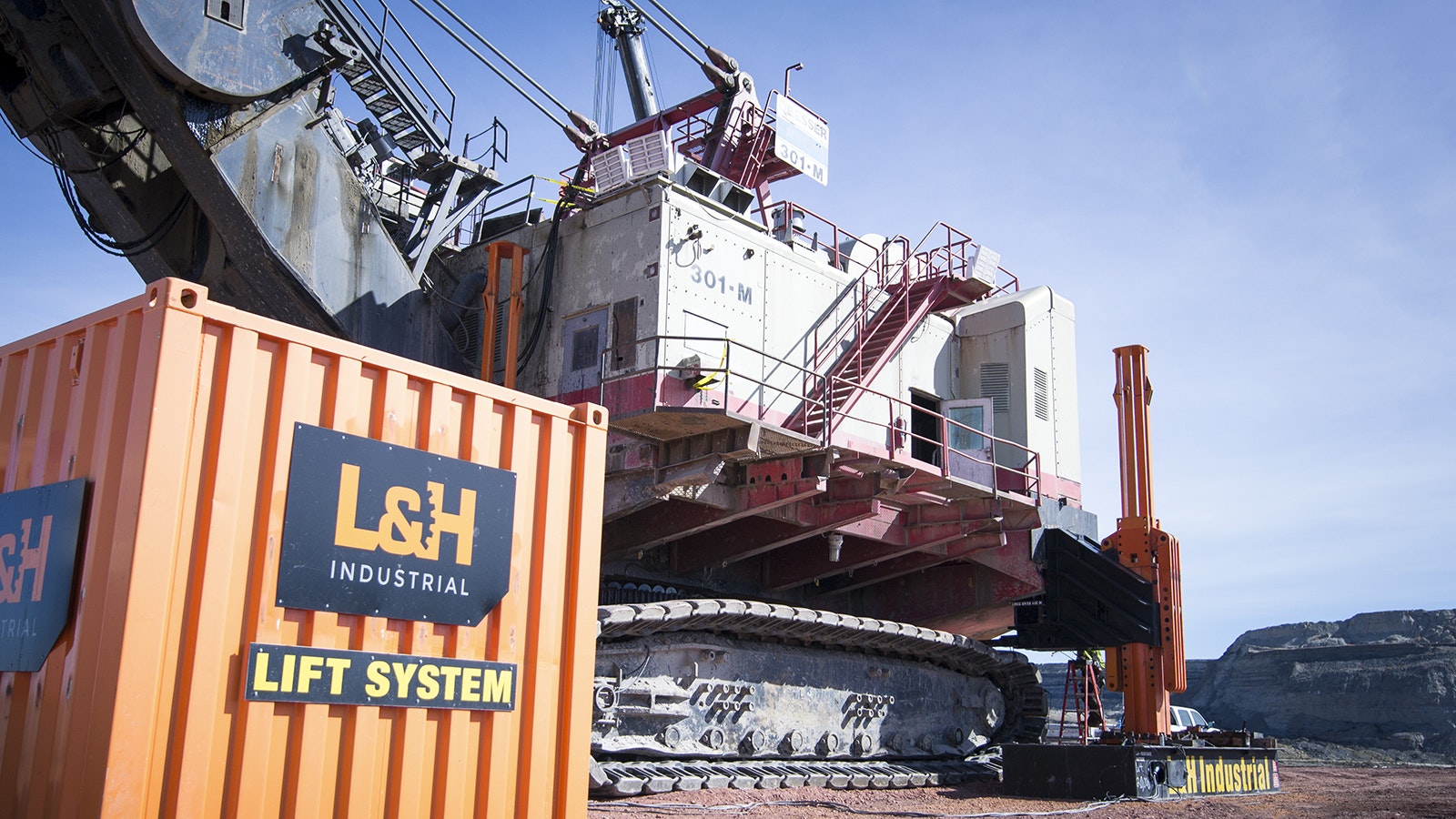The glass on most cellphones comes from a Taiwanese company, but the small country off China’s coast is willing to invest in American manufacturing.
That means cellphone glass could one day come from a Wyoming factory situated near its own trona mines, Gov. Mark Gordon told Cowboy State Daily about what Wyoming is doing to turn American re-shoring efforts under the Trump administration to its best advantage.
Japan, meanwhile, is also interested in investing in Wyoming, Gordon said, and he sees potential for other manufacturing opportunities there, including carbon capture components that have been developed in Gillette.
“It’s fun to come back and report that the tariffs that the Trump administration was putting forward were actually a terrific opportunity for Japan to lower its trade deficit by being able to invest a little bit more in our country,” he said. “And then, at the same time, use our energy for themselves.”
Gordon said discussions about what’s possible with Japan and Taiwan are still ongoing, but he’s optimistic that Wyoming can lasso some of the investments these countries plan to make in America and bring them home to the Cowboy State.
Success would mean not only shoring up use of Wyoming’s natural resources, but also diversifying its economy, a long-sought goal in a state that exports most of its resources to other places, instead of adding value to them in Wyoming.
“Obviously, we have a lot of trona in the western part of the state,” Gordon said. “There’s some silica nearby. It would be great if we could bring some of the manufacturing here and not have to ship our trona out over the rail, which gets expensive, or through a port, which sometimes has problems … to be manufactured elsewhere.”
If Taiwan built a factory near a trona mine in Wyoming, the raw materials could travel a much shorter distance, saving significantly on travel costs, giving the factory a huge geographic advantage.
“Obviously, it’s not going to happen overnight,” Gordon said. “But what are the things we can do to encourage that? Because it’d be wonderful to be able to manufacture high-tech glass right here in Wyoming. So that’s one thing we’re kind of working on.”
Japan, on the other hand, has already had at least some pilot carbon capture components built in Wyoming.
“(Kawasaki Heavy Industries), for example, built a lot of stuff up in Gillette on the Integrated Test Center,” Gordon said. “They’ve now taken some of that technology back to Japan, and they’re putting it on commercial coal plants (for) carbon reduction.”
Japan, Gordon added, is retaining its commitment to a carbon-neutral future, though it plans to still obtain about 20% of its energy from coal.
“As we are able to see these things become commercial, then we can maybe start to manufacture pieces of them,” Gordon said.

Playing The Long Game
Wyoming wants to do more than just be a participant in America’s re-shoring movement; it wants to be a leader.
Part of that, Gordon suggested, is playing the long game.
“Our efforts are really related around how do we make sure that communities have the tools they need to be able to attract and support new industries as they show up,” Gordon said.
Part of that top-to-bottom approach, according to Wyoming Business Council Executive Director Josh Dorrell, is making sure that Wyoming communities are nice places to live, with the proper infrastructure to support economic growth.
“Ultimately what we want to do in Wyoming is make it so that those companies that are (reshoring), they’ll have a good workforce, a good community to be able to be in, and that they have what I would say are peers in those communities,” he said. “So the idea for us is a lot around clustering. Think about if you are a lone company in a community. That’s hard. If you are surrounded by people who are doing similar work to yours, it’s actually a much more cooperative environment than a competitive environment.”
Clusters of similar businesses strengthen each other, Dorrell said. It gives their employees more horizontal and vertical mobility, as well, making recruitment and retention easier.
The other focus, Dorrell said, is making targeted investments that will help communities unlock their economic potential.
“We obviously want to bring in outside firms,” Dorrell said. “But if you think about the individual firms that are here, our communities are constrained by infrastructure and power. So those are two things that are really constraining our communities, and that’s what we’re really looking to do, especially in the infrastructure, so things like water and sewer. How do we help unlock the growth potential in a community with the infrastructure investments?”
Addressing Barriers To Economic Growth
The Wyoming Business Council is also encouraging communities to really examine their true barriers to growth when applying for funds to help economic development projects, as well as some changes to the rules for economic development loans and grants, such as requiring a 25% match from communities.
The match is aimed at ensuring there’s a revenue system in place that can help communities accommodate growth.
“There are tax tools at a local level that need to be fully utilized,” Dorrell said. “If you think about your fifth, sixth, seventh penny taxes, those need to be utilized, because if you start to count it up in the state of Wyoming, and this is a ballpark, (it’s) around a quarter of a billion dollars across the entire state for every one penny.”
Getting more communities to shift into the mode of using at least one of their penny taxes for economic development will help address growth difficulties Dorrell has seen across the Cowboy State in many communities.
“It becomes a matter of, we can pay for the water lines we need, and we can make sure that all of our water treatment plants and all of those things are taken care of,” he said. “Then can we maybe then afford to build our own parks and be able to provide the amenities that young families are looking for? Maybe there’s a way to address the housing problems with that extra revenue they have, so they could actually begin to take care of their own problems and have some level of self-reliance.”

It Won’t Be Easy
Wyoming has a lot to offer businesses that do want to reshore to America, but standing up new manufacturing isn’t for the faint of heart, Gillette-based L&H President Mike Wandler told Cowboy State Daily.
Wandler has been involved in a multi-generational effort to stand up manufacturing in America with his company, which has made components for NASA and is right now involved in nuclear innovation.
“It’s very important, but it’s not for everybody,” he said. “It’s not the easiest way to make money. And the reason it’s not is you have a lot of capital expenditure, so even on your buildings, right, when you put big cranes in, like I do to handle big equipment, you can’t even get an appraisal for any of the money you’ve sunk in the ground or any of the cranes.”
Appraisals might come in at half the real value of a new factory, Wandler said.
“They appraise it like it’s a warehouse, not a manufacturing shop,” he said. “So you have to show up with a lot of money that is going to be worth nothing on Day One. And machines are the same way. So you go buy a $10 million machine, get it planted, and it’s literally, if you went to sell it the day after you turned it on, it would probably sell for $3 million because you have so much sunk cost. It’s worse than a car.”
For those reasons, Wandler believes that becoming a manufacturer isn’t necessarily the right career choice for everyone, and that might be one factor in why it’s become rare.
“You have to love making things and fixing things to get into manufacturing,” he said. “If you love it, and you have a 20-year or longer — the longer of a play you have, the better off you are. Some of the machines I’ve put in are 20 years old and still going strong.”
The sheer size of investment makes standing up manufacturing in America one of the most difficult barriers. And nothing about it works for a get-rich-quick scheme.
“I like people to think multi-generationally,” Wandler said. “So not, how can we set this up and flip it to a private equity in five years and make a ton of money. It’s how do you set it up where it lasts, generationally, and be manufacturing and fixing things for 50 years, 100 years.”
It’s Critical To America’s Future
Wandler sees the effort to bring manufacturing back to America as an existential crisis for not just America, but the world.
“When you talk about the Chinese Communist Party, when you look at their values and their mission, it’s to dominate the earth, right?” Wandler said. “They want to spread the Chinese Communist Party — communism — globally. Just like we want, the USA wants to spread freedom globally.”
To accomplish its aim, China has for decades engaged in predatory pricing, manufacturing goods and selling them cheaper than their actual cost.
“How China gets away with it is they pegged their yuan to the U.S. dollar,” Wandler said. “They said, ‘Well, we’re not going to let our currency fluctuate. We’re going to peg it to the U.S. dollar, and then we’re going to grow aggressively. We’re going to grow our way out of the fact that we’re losing money all the time.’”
Predatory pricing has allowed China to gather up a substantial amount of manufacturing work to itself, creating a power imbalance.
“This is really not a tariff war or anything else,” Wandler said. “China is very close to dominating the world because we’ve let them take over all our manufacturing … and that’s not a good world for the rest of us.”
China has found ways to still get products into America, Wandler added, by using a back-door route that leads through Canada and Mexico.
“That’s why we’ve seen Trump saber rattling with Mexico and Canada,” he said. “It’s not because he wants to do the tariffs and be mean. It’s that you can’t let it happen. We have to be in this together as the free North America. We have to work together to stop China from dominating (the world).”
Restoring the balance of power is something America just has to do, Wandler said.
“Even if we have to pay twice as much for products, this has to happen,” he said. “Or the free world is coming to an end. We’ll all be under Chinese Communist Party rule.”
Not Your Grandpa’s Factory
The new factories that return to America won’t necessarily look at all like Grandpa’s factory, and the jobs won’t be the same either. Think robots and automation, combined with very high-paying jobs for the people who remain.
“I believe that most of it, a lot of it, can be brought back to the USA now, because of technology in robots,” Wandler said. “The hard nasty work that an American would not want to do, or that the American who is making $35 an hour plus benefits, you couldn’t afford it. Now you could have one American making $50 an hour, and they can have a robot or two or three that make it to where you can be competitive with people in countries with cheap labor.”
That’s particularly interesting for Wyoming, Wandler said, because lack of labor has been one of the headwinds to standing up manufacturing in the Cowboy State.
“That’s one of the reasons you don’t put manufacturing in Wyoming is that we only have half a million people,” he said. “That’s a problem, right? We need people to manufacture. Not anymore … Wyoming is full of people who love to fix things and make things and you can wrap around them some technology — some AI, some robots, some CNC machines — and all of a sudden that one person can do the work of five or 10 people and you can pay them extremely well, and they can be competitive with anybody in the world (with labor) that’s charging $2 or $3 an hour.”
That approach removes expensive labor or lack of labor at all as a barrier to locating manufacturing plants in Wyoming, Wandler said.
“So having cheap labor is no longer a competitive advantage in manufacturing,” Wandler said. “Having people with a great work ethic who are wrapped with technology, that’s the new competitive advantage. So that’s the reason that this stuff can come back to the USA and can come back to Wyoming.”
A Targeted Approach
Not everything, however, should necessarily come back when it comes to manufacturing. Manufacturing Works Director Rocky Case supports the needs of small to medium manufacturers in Wyoming. He hopes to see strategic thought around the types of manufacturing that return.
“Just from national security all the way down to day-to-day consumer items that we need, it’s something that we need to address, because we’re very reliant on foreign markets to support all of what we call the critical manufacturing needs of the U.S.,” he said. “Which really include Department of Defense, transportation, all things under the medical umbrella, and food security.”
The brittleness of American supply chains was exposed during the COVID-19 pandemic, when store shelves were sometimes bare and people worried about getting enough food and other critical supplies.
But not all products make equal sense.
“I think of toys on Walmart shelves,” he said. “We’re not going to be able to manufacture that in the United States at a cost that’s going to be in the realm of something someone is going to want to pay. The cost goes through the roof because of the regulatory environment, labor costs, and a number of different things.”
Items that make more sense to Case either have a large value chain, or they’re critical for health and safety.
“We need to be strategic about the what and the why,” he said. “What and why are we bringing it back? Does it contribute to national security? Does it contribute to food safety? Does it contribute to our ability to get about the country or about the state or wherever, right?”
The Global Village
National security issues aside, one of the biggest questions around reshoring American manufacturing isn’t just whether tariffs can help force the issue, but making sure it’s all sustainable over the long haul, economist and University of Wyoming Assistant Professor of Supply Management Abhay Grover told Cowboy State Daily.
“To some extent, (tariffs) are working,” he said. “We’ve seen a large growth in important key industries in the United States. You can see that manufacturing, the base of manufacturing has started growing.”
Like Case, Grover feels sustainability will depend on the kinds of products in question.
“When we talk about let’s say labor-intensive products, like shoes, let’s say just sneakers or apparel merchandise, these are super labor-intensive products,” he said. “To compete in some of these products, we are outsourcing these to countries like let’s say Vietnam or India or Bangladesh.”
Cheap labor is the reason for that, but these countries also have developed knowledge and skills for the task.
“I think from a labor intensity standpoint, it’s very difficult to kind of replace the competitiveness of these products,” Grover said. “Right now if we look at products which are less labor intensive, which could have standardization in terms of automation — we have to be super competitive in the United States, so I think automation is the key.”
Companies are also not just going to look at tariffs when they make decisions about returning a plant to the United States, Grover added.
“The world is a global village now, with technology and everything else,” he said. “So I think there’s more than tariffs that impact these decisions. When we talk about near-shoring or local sourcing, there are advantages that come with it, which I think from a long-term sustainability perspective, are really critical.”
Renée Jean can be reached at renee@cowboystatedaily.com.









